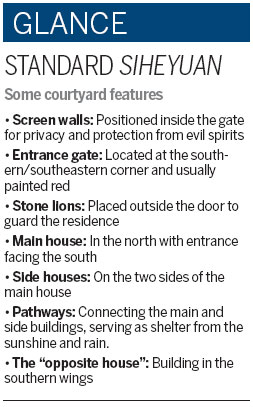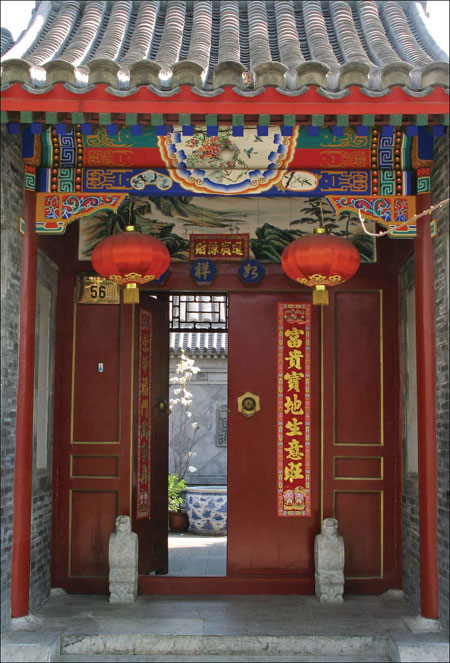Within these walls
Updated: 2012-07-06 12:28
By Sun Yuanqing (China Daily)
|
|||||||||||
|
More and more rich people are finding solace in siheyuan as Beijing becomes increasingly crowded. Zhang Kaixin / for China Daily |
Taste for traditional courtyard homes experiences revival, with some modern takes
After living in a modern high-rise apartment in Beijing for several years, Yang Ningjia decided to give up that dream of most young Chinese urbanites. Instead, he moved back to a traditional Beijing courtyard house, or siheyuan. "It is said that people who live in siheyuan tend to enjoy longer lives because of their intimacy with nature," the successful investor says.
One of his favorite things about the old courtyard home is, after a hard day's work, being able to rest under the trees he planted with the sky "high above" and "real soil" beneath his feet.
Yang is one of a growing number of rich Chinese who are finding solace in the traditional dwelling of a capital that is becoming increasingly crowded and fast paced.
Beijing's siheyuan, many of which became run-down and extremely crowded in the mid-20th century, are regaining their former allure by becoming some of the most sought-after real estate and architecture at a time when private space comes at a premium.
The Olympic Family Hotel program launched during the 2008 Beijing Olympics allowing visitors to live in local siheyuan households to get a taste of the Beijing way of life amid its hutong alleyways also piqued interest in the architecture.
Amid high property prices in the capital and government efforts to rein them in, the average price of siheyuan has rocketed from about 15,000 yuan ($2,360, 1,880 euros) a square meter in 2007 to as much as 100,000 yuan now.
A 200-square-meter renovated siheyuan can cost up to 20 million yuan, while larger units can cost many times more, says Dai Zhenyu, a property agent who grew up in siheyuan himself and specializes in the compounds.
With a history of more than two millenia, siheyuan are mostly seen in North China, and are residential space associated especially with the Chinese capital. A typical siheyuan consists of an ample square yard with four buildings on each side, hosting one extended family. Some siheyuan have several layers of courtyards, demonstrating the wealth and status of the owners.
The layout of a siheyuan strictly follows Confucian ideas of respecting authority and the old. The northern main house, which receives the most sunshine, should belong to the eldest member of the family. The east and west wings house the second and third generations, while the southern building that is closest to the doorway is usually inhabited by household servants and guests.
The entrance gate is also often adorned with colorful patterns that are supposed to bring the family luck and wealth. A pair of stone lions can also be seen in front of the residence of a prominent family as a symbol of power and wealth.
But in the mid-20th century many of the courtyards were transformed into residential complexes as the population in Beijing boomed. Several households had to share one siheyuan and the courtyard, originally designed as an open-air "living room", also came to be used by small households. In the 1990s, many siheyuan were torn down to make room for apartment buildings.
Many old and neglected courtyard homes ended up as a last choice for city-dwellers who were scrambling for apartment buildings equipped with modern amenities.
But for many Beijingers who grew up in siheyuan, the courtyards represent valuable memories and traditional home comforts that cannot be replaced by the trappings of modern life.
 |
Well-preserved siheyuan are now concentrated in the eastern and western parts of old Beijing as these are the areas where the nobles used to live in ancient times. Neighborhoods like Nanluoguxiang, Shichahai and Nanchizi have also become some of the most popular siheyuan areas because of their rich architectural heritage and convenient location.
Instead of simply renovating the existing structures, Dai says many siheyuan buyers are rebuilding their structures from scratch.
Modern amenities are increasingly being added to the courtyard to cater to the buyers. Basements are developed as wine cellars and karaoke rooms. Windows are opened for better airing at the top and back of rooms, places that were previously supposed to be private. Luxurious bathrooms with all the frills are being added while sophisticated air conditioning and heating systems are included.
Dai says that while most of the buyers are Chinese, about one-fifth of his customers are foreigners, most coming from European countries including Germany, France and Britain. They then mix European architectural elements into their siheyuan. In the rental market, almost 70 percent of the clients are foreigners, mostly French, he says.
And for those who are only in Beijing for a short stay, siheyuan boutique hotels offer another choice. Equipped just like any top hotel in the city, the hotels appeal to visitors with a touch of local life.
"Most of our guests are tourists from Europe and the US who are interested in hutong culture and Beijing local life," says Du Ge, founder and general manager of Duge boutique hotel, a siheyuan hotel in Nanluoguxiang.
The yard was renovated at a cost of 10 million yuan, from a housing complex to a luxurious hotel that includes a wine cellar and a children's playhouse. Much was changed except the original layout, Du says.
The rooms cost about 2,000 yuan a night, similar to that of five-star hotels. Many say rarity, combined with modern amenities and luxury, gives these siheyuan hotels an edge.
"Siheyuan gives me a sense of the real Beijing," says Michelle Friedman, a tourist from the United States. "We can live and eat like locals here, with all the modern luxuries available."
But for some, the feeling for siheyuan runs deeper.
"I don't really have to work after dealing in the business for a few years. But I stayed on," Dai says. "Because I love siheyuan and I love to have more people appreciate and enjoy this very unique aspect of architecture."
Contact the writer at sunyuanqing@chinadaily.com.cn
Today's Top News
Rescuers race against time for quake victims
Telecom workers restore links
Coal mine blast kills 18 in Jilin
Intl scholarship puts China on the map
More bird flu patients discharged
Gold loses sheen, but still a safe bet
US 'turns blind eye to human rights'
Telecom workers restore links
Hot Topics
Lunar probe , China growth forecasts, Emission rules get tougher, China seen through 'colored lens', International board,
Editor's Picks

|

|

|

|

|

|






